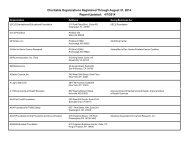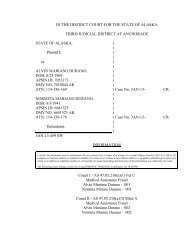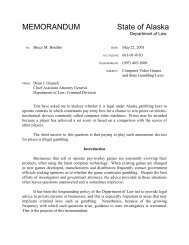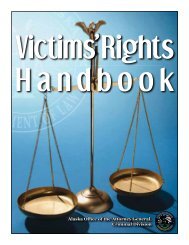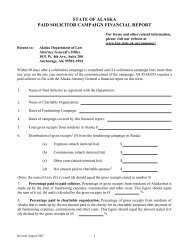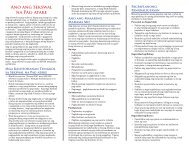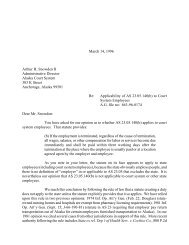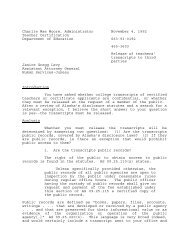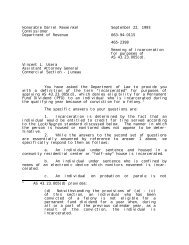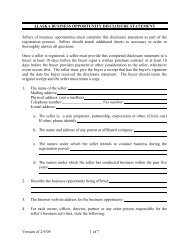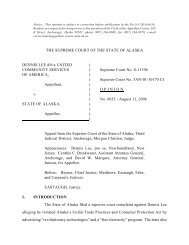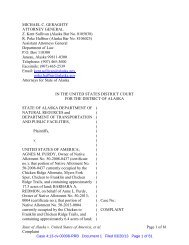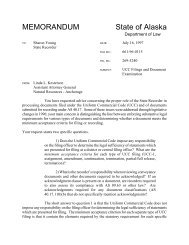Initial Report and Recommendations - Alaska Department of Law
Initial Report and Recommendations - Alaska Department of Law
Initial Report and Recommendations - Alaska Department of Law
- No tags were found...
Create successful ePaper yourself
Turn your PDF publications into a flip-book with our unique Google optimized e-Paper software.
______________________________________________________________________________D-DS 6Statement <strong>of</strong> problem:Prevention programs in rural <strong>Alaska</strong> do not have sufficient resources to do prevention.Current Status:a) Kawerak has a dual track program, provides prevention services to children <strong>and</strong> their families.(MOA available for review).State DHSS <strong>of</strong>fers a few mini grants to provide preventive services (Safe <strong>and</strong> Stable FamiliesTitle IVB funding).AFN Wellness initiative provided for some prevention type programs in rural <strong>Alaska</strong>.Wellness Initiative – 4 areas covered: Control <strong>of</strong> Alcohol, Supporting VPSO, Enforcing localoption law, <strong>and</strong> violence prevention. Best practices shared among villages.b) ANDVSA DELTA project (CDC grant) funds prevention programs in Valdez, Sitka, Juneau,Dillingham.c) TCC <strong>and</strong> YKHC Regions have Tribal Family <strong>and</strong> Youth Specialists in every village, but theyare stretched with multiple duties that do include prevention activities but also include childprotection services. Nothing targeted specifically for prevention.d) Tundra Women’s Coalition in Bethel has a prevention program for teens.Ideal Status:a) Prevention programs coordinated, non-duplicative, cultural appropriate effective locally orvillage based provided throughout Rural <strong>Alaska</strong>.b) An initiative in each village to spearhead prevention workshops <strong>and</strong> healthy activities.c) Have smaller organizations work together, coordinating regularly.d) Utilize successful already established models.e) Have well funded prevention projects with capacity for intervention when prevention workuncovers issues.Structural Barriers (e.g., statutes, regulations, etc.):a) Very few Funding opportunities for prevention activities.b) Funding <strong>and</strong> expertise.c) Different funding streams not being coordinated at village or statewide level.d) Funding mechanisms do not exist to help groups providing services or new funding.e) Most <strong>of</strong> time spent in intervention rather than prevention.Option(s):a) Prevention programs available in the schools <strong>and</strong> <strong>of</strong>fered by DV/SA, tribal, state <strong>and</strong> non-pr<strong>of</strong>ithealth organizations, tribal councils or AK Native Village agencies that provide crisisintervention services.b) Review <strong>of</strong> Family Wellness Warriors Initiative (Southcentral Foundation) <strong>and</strong> other local <strong>and</strong>regional initiatives.c) Statewide curriculum available for use in every village, with statewide staff support fortechnical assistance to the villages.d) Existing programs have funds to <strong>of</strong>fer newly developing prevention projects the training <strong>and</strong>technical assistance they need to build a foundation.______________________________________________________________________________D-DS 7Statement <strong>of</strong> problem:There are not enough healthy youth <strong>and</strong> family activities in rural <strong>Alaska</strong>.<strong>Alaska</strong> Rural Justice <strong>and</strong> <strong>Law</strong> Enforcement Commission - Page 98



